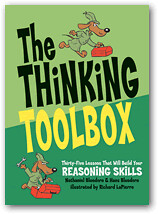

The Thinking Toolbox by Nathaniel Bluedorn & Hans BLuedorn is a book about reasoning skills aimed at children 13 years and up.
While in general, the author make a good effort at keeping the lessons clear and the examples fun while educational, there are some shortcomings. Therefore, I cannot recommend the book wholeheartedly. Some of the shortcomings can easily be addressed and I hope they will disappear in the next edition of the book.
In the following, I'm going to point out some of the issues that will need to be addressed.
1. It would have been better to point out that the author's definition is just one possible definition of "argument". Or they could have called it a "logical argument" instead. (See Lesson 2)
2. When the authors mention emotional involvement as being something negative, they leave out things like compassion and love which would constitute positive emotional involvement. It should just be pointed out that one needs to keep a clear head for a discussion or argument. (See Lesson 2)
3. The list of categories of conversation seems to be incomplete. What category does smalltalk belong to? (See Lesson 2) In lesson 3, exercise 5, the guys are not having an argument, but they are playing a game; possibly this could be called a fake argument.
4. In the exercises for lesson 5, too many of the arguments are dumb arguments. The issue of distinguishing good from bad arguments or real evidence from fake evidence etc is kind of addressed later-on, but not specifically enough. It should have been addressed earlier and in a separate chapter. Lesson 6 about beliefs would be more useful with this issue already clearified.
5. The authors create a false dichonomy between creation and evolution (Lesson 7).
At the end of the lesson, the authors say: "The act of seriously trying to defeat our own arguments and anticipating arguments for the other side is very useful because it humbles us. We begin to realize that the reasons why we believe things might not be entirely on good reasons." They should heed their own advice more often!
6. In lesson 10, I'm wondering why the authors are using sthe stupid example about a dinosaur. No scientist would ever make a claim even close to what the museum tour guide claims. A real-world example should have been used instead.
** The authors follow up with an important and worthwhile observation, though, that just because we read something in a book, that doesn't mean it's true. And "Don't assume that the viewpoint you are reading about is the only one."
7.
In the answer key for the exercises, the authors should distinguish between the cases where they state the one right answer and where they are giving just one example of a possible right answer.
Despite these shortcomings, the book is quite helpful for improving your reasoning skills.
*disclaimer: I received a free copy of this book from the publishers through Mind and Media (now called Active Christian Media) in exchange for my services as a reviewer.

